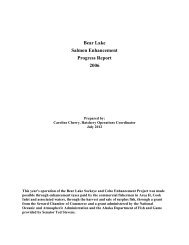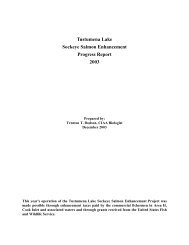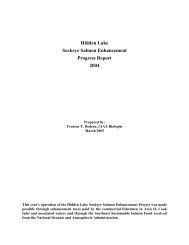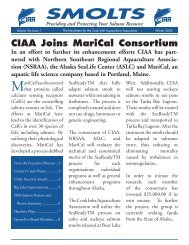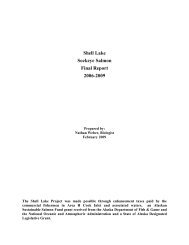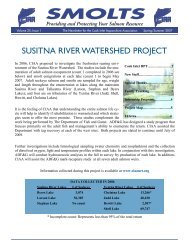Tustemena Lake 2006 - Cook Inlet Aquaculture Association, Kenai ...
Tustemena Lake 2006 - Cook Inlet Aquaculture Association, Kenai ...
Tustemena Lake 2006 - Cook Inlet Aquaculture Association, Kenai ...
You also want an ePaper? Increase the reach of your titles
YUMPU automatically turns print PDFs into web optimized ePapers that Google loves.
ABSTRACT<br />
The Alaska Department of Fish and Game (ADF&G) began the Tustumena <strong>Lake</strong> sockeye<br />
enhancement program in 1974. In 1976, the first fry resulting from egg collections were released<br />
to Tustumena <strong>Lake</strong>. During the project, eggs were collected from Bear Creek, Glacier Flats<br />
Creek, and Seepage Creek in varying combinations. As the project progressed, as many as 23.6<br />
million eggs were collected and as many as 17.1 million fry were released into Tustumena <strong>Lake</strong>;<br />
and up to eight other lakes were stocked with fry of Tustumena origin. Currently 12 million<br />
eggs are collected from Bear Creek and 6 million are released to Tustumena <strong>Lake</strong> and 3.4<br />
million to three lower <strong>Cook</strong> <strong>Inlet</strong> lakes.<br />
In 1993, CIAA assumed operation of the Tustumena <strong>Lake</strong> sockeye enhancement program from<br />
ADF&G. Initially, ADF&G maintained the responsibility of conducting the Tustumena <strong>Lake</strong><br />
limnological sampling, smolt migration and adult escapement and CIAA accepted the<br />
responsibility of enumerating the spawning population at the Bear Creek gamete collection site,<br />
collecting gametes for the enhancement program, incubating, rearing and releasing the resulting<br />
fish. In 1998, CIAA assumed the responsibility of enumerating the smolt migration and<br />
conducting the limnological sampling.<br />
In January 2004, a ruling by the 9 th Circuit Court of Appeals found that the enhancement project<br />
occurring on Tustumena <strong>Lake</strong> was a commercial enterprise and thus, violated the Wilderness<br />
Act. As a result, the United States Fish and Wildlife Service were no longer able to provide<br />
CIAA with a permit to continue operations on Tustumena <strong>Lake</strong>. The resultant fry from the 2003<br />
egg collection were allowed to be released; however, all other activities were terminated.<br />
This report summarizes the <strong>2006</strong> Tustumena <strong>Lake</strong> smolt migration. The Bear Creek adult<br />
enumeration and gamete collection activities, otolith collection activities, and the limnological<br />
sampling were terminated in 2004.<br />
The enumeration of sockeye salmon smolts migrating from Tustumena <strong>Lake</strong> was conducted at<br />
mile 6.3 of the Kasilof River from 22 May to 26 June using a mark/recapture technique<br />
developed by ADF&G. The smolt migration totaled 2.8 million (± 756,000) fish and was<br />
composed of 90.7% (± 26.3%) age 1 smolts and 9.3% (± 3.6%) age 2 smolts. The age 1 smolts<br />
averaged 81.8 mm (± 0.86 mm) in length and 4.52 g (± 0.08 g) in weight; the age 2 smolts<br />
averaged 97.9 mm (± 2.26 mm) in length and 7.40 g (± 0.58 g) in weight. There were no fry<br />
released in 2005, thus smolts resulting from fry released by CIAA in 2004 made up 0.04%<br />
(±0.05%) of the migration.<br />
CIAA also sampled the hatchery outfall for hatchery-reared Tustumena stock adults returning to<br />
the hatchery. There were no adult sockeye observed at the Trail <strong>Lake</strong>s Hatchery outfall in <strong>2006</strong>.<br />
1



